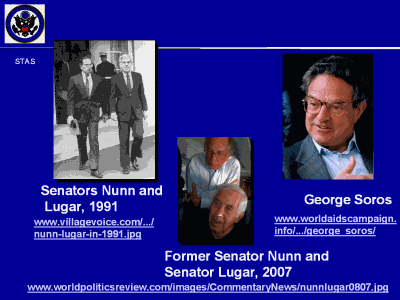| front |1 |2 |3 |4 |5 |6 |7 |8 |9 |10 |11 |12 |13 |14 |15 |16 |17 |18 |19 |20 |21 |22 |23 |24 |25 |26 |27 |28 |29 |30 |31 |32 |33 |34 |review |
 |
Through the chilly decades of the Cold War of the last century, scientists in the west continued to communicate with their counterparts behind what was called “The Iron Curtain” – an almost forgotten term. Indeed, many have credited these continuing communications, particularly among physicists, with preventing a flash-over of the Cold War. In the immediate wake of the disintegration of the Soviet Union, both the US government and philanthropist George Soros invested significantly in the science and scientists of the former Soviet Union, albeit for rather different reasons. Under the leadership of Senators Sam Nunn and Richard Lugar, in 1991 Congress established the Cooperative Threat Reduction program (within the Defense Threat Reduction Agency or DTRA). The objectives were to clean up nuclear, chemical and biological weapons and to find employment for the tens of thousands of Soviet scientists who had worked on such weapons. A number of International Science and Technology Centers were established to employ weapons scientists and engineers in civilian research and development. In 1992, philanthropist George Soros* was persuaded by Russian-born US scientists to donate $100 million dollars to keeping science – and scientists in the Former Soviet Union – afloat through the initial post-Soviet period of instability. He founded the International Science Foundation – or ISF – whose founding board I was invited to join under the chairmanship of the late Nobel Laureate Joshua Lederberg. To keep FSU scientists connected and funded, the ISF provided personal grants, travel grants and research grants; it had a telecommunications program and a library assistance program, which I headed, to maintain the flow of scientific literature to libraries in universities and institutes. One of my first experiences in active science diplomacy was accompanying George Soros to Moscow to meet with Boris Yeltsin to urge him not to tax Foundation funds. Curiously, both of these early programs continue – and continue to evolve. Soros’ foundation did not survive his initial gifts, but morphed into the U. S. Civilian Research and Development Foundation – CRDF – which today supports cooperative projects between FSU and US industries – as well as many other international science activities. Nunn and Lugar continue to be involved in the tough task of cleaning up the weapons stockpiles. A part of the original Nunn-Lugar CTR program was transferred to the State Department and continues to supports on-going programs, often through the CRDF. |